Vaccination: to Kill that Which Isn't Living, Part 3 of 5
Posted at 16:25 MST
Pre Read
This is the 3rd part of my series, you can check out the first 2 parts, if you haven't already, below this paragraph. The reason is to build up the knowledge of what a vaccine is and how it works with the body and its effectiveness in the real world. The goal is to be as accurate as possible without being too confusing, so if you find that there is anything that can should be clarified as it is confusing or incorrect then please let me know. This post is in reference to humans and as such some of the information may be inaccurate if taken into context of all animals on the planet. This post is a little shorter and rarely has direct references because a lot of the material is simplified and combined from multiple sources making it difficult to pinpoint exactly where I got everything from. The post itself is a little bit shorter than I would like but I hope it covers all of the content. If you have any questions, comments, or anything then please reply or else message me on steemit.chat at kryzsec or on discord at opticcncfan. Thank you for reading!
| From Inoculation to Vaccination: | Here |
|---|---|
| The Immune System of Phagocytes: | Here |
Quick Recap
This video goes over a few important topics that we have already covered such as antibodies and antigens though is slightly inaccurate how they work, for a more correct version watch the video here. The reason why I am bringing this up is because this post is going to be about viruses.
The Virus
Viruses are our first stop in this post and are, in many senses, one of the most complex things about this subject. You see with all of our knowledge about viruses there is still, to some extent, a debate on whether a virus is living or not. While ultimately it depends on what your definition of living is, the general answer is that they are not.[1]. This post is not about arguing the semantics surrounding the definition of alive to determine the state of a virus but will instead give you a brief overview of a few viral traits without getting too much into genetics.First of all, for simplicity, I will classify viruses into 2 main groups: retroviruses (viruses that use reverse transcription) and non retroviruses or just viruses.
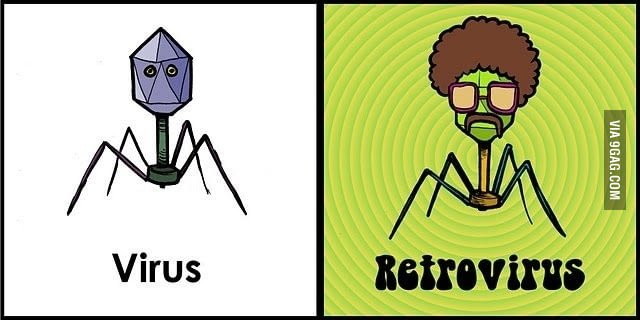
Source
Retrovirus
A retro virus is any virus that keeps its genetic code as RNA and transcribes it into DNA during infection. This includes viruses like HIV and HTLV[2]. So for people that may not know as much about molecular genetics, basically a retrovirus changes its RNA into DNA (human genetic code) and then inserts the DNA into the genome making a provirus and when the host cell goes to use the DNA to make proteins it makes the proteins the virus wants it to make which replicates the virus.
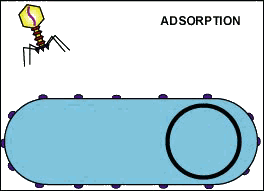
Non-retroviruses or Viruses
Regular viruses are a little unique as some of them keep their genetic code as RNA and some of them keep it as DNA, and how they work is different depending on each virus.
RNA based viruses work because the human cells convert DNA into RNA before using it to make proteins. So when the RNA virus sends its genetic code into the host cell it is already transcribed and will get picked up by a protein production mechanism and start to reproduce the virus. DNA based viruses work by injecting their own DNA into the host DNA and letting the host transcribe it to RNA and reproduce the virus.
Ultimately the way that a virus stores its genetic material though isn't the major thing that we are concerned about until it comes back to mutations. Next we are going to have 2 separate classifications for a virus, does it have an envelope or not.
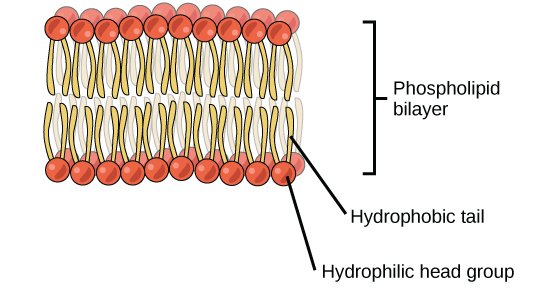
Source
Viral Envelope
Our cells have whats called a cell membrane holding them together. The cell membrane is made of a phospho-lipid bilayer (as seen above) and on its surface is where you will find our cells antigens. You see a viral envelope is a protective coating made of the exact same substance that covers the surface except it has some unique proteins covering it. What I didn't tell you in the previous post about antigens is that they are, I believe, mostly made of sugars so it isn't the proteins that our immune cells look for but sugars. Anyways, the proteins on a viral envelope are designed to grab the sugars of a host cell and make the hosts immune system think that it is just another cell of that host, as it has the proper antigens. Certain viruses, like influenza and HIV, use this and make it much harder to have an accurate vaccine against them. Other viruses, such as the rabies virus, does not have an envelope which is why we do not need to make a special rabies vaccine constantly where as the flu you do. Beyond the envelope, most viruses have some set of structure that they can be classified as but that is well beyond the scope of this.
Mutations
A mutation is anytime the genetic code is altered, sometimes they are silent meaning the genetic code changed but it didn't have any phenotypic effect, and other times they have the ability to turn genes on, off, or make new genes altogether. This is in general the basis behind evolution which is that when genetic material is copied, mistakes are sometimes made and those mistakes can alter how the virus behaves. Now some viruses are more prone to mutations over others and the reason for this has many factors but the biggest one I am going to go over is the method by which they store their genetic material. You see DNA is double stranded and only truly fits together if both strands properly cooperate by being exact opposites. What this means is that if a mutation happens in one strand then it will not properly fit together with the other strand so there are very easy methods to determine DNA has mutated making it much harder for DNA to mutate (but it is possible) however since RNA is single stranded it doesn't have this problem and is much harder to determine a mutation. This means that viruses that store their genetic code as RNA are more likely to have mutations and those mutations can affect many things (from their antigens, their behaviors, proteins coded for, etc). Now if a mutation changes its antigen then the immune system will no longer be able to recognize the virus and the previous antibodies will no longer work, thankfully that is generally rare. This is the explanation for why you need to get some vaccines only a few times and others you require updating constantly, and even explains why some viruses (HIV) are really difficult to create vaccines for.
Something I haven't mentioned here is that viruses are small, so small that regular microscopes cannot see them, with a few exceptions such as Pandoraviruses. So the fact that our body has the ability to find these guys is very very special but also means it is very very hard. In comparison, if we took an average bacteria (5 um) and scaled it up to a lego block (31mm) the virus would be roughly the size of the knob on top of the brick at most
Note: there was an edit in here about viruses being seen through a microscope from @stempede and the moderators in control of that account.
References
Quick reads by @Suesa
steemit.com/science/@suesa/wtf-is-a-virus
steemit.com/science/@suesa/finding-a-virus
steemit.com/science/@suesa/cervical-cancer-another-virus-induced-problem
Wiki Pages on the Subjects
en.wikipedia.org/wiki/Virus
en.wikipedia.org/wiki/Retrovirus
en.wikipedia.org/wiki/Viral_envelope
en.wikipedia.org/wiki/RNA
en.wikipedia.org/wiki/DNA
en.wikipedia.org/wiki/Mutation
Images (Not from Wikipedia)
www.facebook.com/pedromics/photos/a.110862089106492.1073741828.110856429107058/110865022439532/?type=3&theater
thumbs.gfycat.com/IncredibleJointAfricanmolesnake-small.gif
NCBI Articles
www.ncbi.nlm.nih.gov/books/NBK7934
www.ncbi.nlm.nih.gov/genomes/GenomesGroup.cgi?taxid=10239
www.ncbi.nlm.nih.gov/books/NBK8174/
www.ncbi.nlm.nih.gov/genome/viruses/retroviruses/ www.ncbi.nlm.nih.gov/books/NBK19382/
Sources Directly Referenced
[1] www.livescience.com/58018-are-viruses-alive.html
[2] www.ncbi.nlm.nih.gov/books/NBK7934/
Sources Not Directly Referenced
aidsinfo.nih.gov/understanding-hiv-aids/glossary/634/retrovirus
exploringorigins.org/rna.html
www.rnasociety.org/about/what-is-rna/
ghr.nlm.nih.gov/primer/basics/dna
www.els.net/WileyCDA/ElsArticle/refId-a0001091.html
ghr.nlm.nih.gov/primer/mutationsanddisorders/genemutation
Do you enjoy reading or writing topics related to STEM (Science, Technology, Engineering, and Mathematics) then I would suggest checking out @steemstem! They do wonderful work curating the best STEM related posts on Steemit. For more information check out the SteemStem chat room on steemit.chat or check out their Guidlines and start writing.
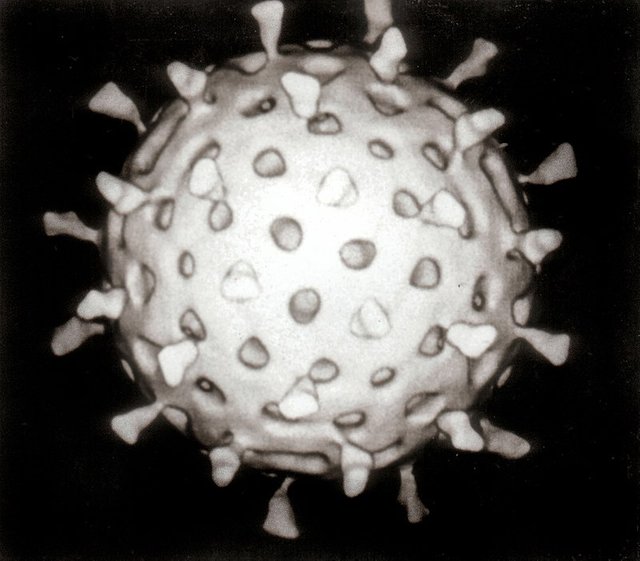
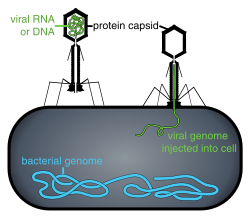








This post received a 98.42% upvote from @randofish1 thanks to @kryzsec!
For more information, click here!
Good work of research. Yet to justify the title though, perhaps reading the rest will take care of that
It works in contrast with the previous one to explain viruses specifically. Technically you do not "kill" a virus by you can either destroy it or inactivate it as the majority agrees that viruses are not constituted as living things (they do not eat, cannot reproduce on their own, they do not grow, and some have not really been seen to 'age')
The entire implication of 'to kill that which isn't living' is ultimately in reference (for myself) to a book that I read in elementary school where the protagonist has to defeat death but since death was not living they could not kill death so they instead opted for destroying deaths body... and then restarted the universe to prevent that from happening. I understand that it is likely that nobody will get this reference (as the book series wasn't very popular) and even those whom have read the series wouldn't likely make the connection. If you want to inactivate a virus you have to look at which virus specifically but in general acidic environments can destroy the protein capsid.
Anyways before I write a reply that is as long as the post (I sometimes have problems with finding when I should stop talking when I am passionate about something) I will say thanks for the feedback!
You have done justice to my question by your explanation. Well done
Received 1.6x reward. from @koinbot, @steemfunding, ...
@originalworks
The @OriginalWorks bot has determined this post by @kryzsec to be original material and upvoted(1.5%) it!
To call @OriginalWorks, simply reply to any post with @originalworks or !originalworks in your message!
Congratulations @kryzsec, this post is the forth most rewarded post (based on pending payouts) in the last 12 hours written by a User account holder (accounts that hold between 0.1 and 1.0 Mega Vests). The total number of posts by User account holders during this period was 2748 and the total pending payments to posts in this category was $2027.11. To see the full list of highest paid posts across all accounts categories, click here.
If you do not wish to receive these messages in future, please reply stop to this comment.
@reported has voted on behalf of @minnowpond.
If you would like to recieve upvotes from minnowponds team on all your posts, simply FOLLOW @minnowpond.